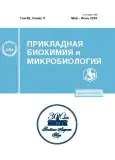Effect of the Glyoxylate Shunt Inactivation on Biosynthesis of Adipic Acid Through the Inverted Fatty Acid β-oxidation by Escherichia coli Strains
- Authors: Gulevich A.Y.1, Skorokhodova A.Y.1, Debabov V.G.1
-
Affiliations:
- Federal Research Centre “Fundamentals of Biotechnology” of the Russian Academy of Sciences
- Issue: Vol 59, No 3 (2023)
- Pages: 235-243
- Section: Articles
- URL: https://journals.rcsi.science/0555-1099/article/view/138769
- DOI: https://doi.org/10.31857/S055510992303008X
- EDN: https://elibrary.ru/BBSGQX
- ID: 138769
Cite item
Full Text
Abstract
Using Escherichia coli MG1655 lacIQ, ∆ackA-pta, ∆poxB, ∆ldhA, ∆adhE, ∆fadE, PL-SDφ10-atoB, Ptrc-ideal-4-SDφ10-fadB, PL-SDφ10-tesB, ∆yciA as a core strain, the derivatives capable of synthesizing adipic acid from glucose through the inverted fatty acid β-oxidation pathway were obtained. Biosynthesis of the target compound by recombinants was ensured upon the primary condensation of acetyl-CoA and succinyl-CoA by 3-oxoacyl-CoA thiolase PaaJ and the catalysis of the final reaction of the cycle by acyl-CoA dehydrogenases FadE and FabI. Deletion in the strains of sucCD genes encoding components of succinyl-CoA synthase did not increase the relative intracellular availability of succinyl-CoA for target biosynthetic reactions and did not lead to an increase in adipic acid accumulation by the recombinants. The secretion of succinic and malic acids by the strains with an impaired tricarboxylic acid cycle remained almost unchanged, indicating the activity in the cells of glyoxylate shunt reactions that compete with the cycle reactions for isocitrate, required for succinyl-CoA formation. When isocitrate lyase, malate synthases A and G, and bifunctional kinase/phosphatase isocitrate dehydrogenase were inactivated in strains due to deletion of the aceBAK operon genes and glcB, adipic acid synthesis by recombinants increased threefold and reached 0.33 mM.
About the authors
A. Yu. Gulevich
Federal Research Centre “Fundamentals of Biotechnology” of the Russian Academy of Sciences
Author for correspondence.
Email: andrey.gulevich@gmail.com.ru
Russia, 117312, Moscow
A. Yu. Skorokhodova
Federal Research Centre “Fundamentals of Biotechnology” of the Russian Academy of Sciences
Email: andrey.gulevich@gmail.com.ru
Russia, 117312, Moscow
V. G. Debabov
Federal Research Centre “Fundamentals of Biotechnology” of the Russian Academy of Sciences
Email: andrey.gulevich@gmail.com.ru
Russia, 117312, Moscow
References
- Lang M., Li H. // ChemSusChem. 2022. V. 15. № 1. e202101531. https://doi.org/10.1002/cssc.202101531
- Skoog E., Shin J.H., Saez-Jimenez V., Mapelli V., Olsson L. // Biotechnol. Adv. 2018. V. 36. № 8. P. 2248–2263.
- Thomas J.M., Raja R., Johnson B.F., O’Connell T.J., Sankar G., Khimyak T. // Chem. Commun. 2003. V. 21 № 10. P. 1126–1127.
- Lin Y., Sun X., Yuan Q., Yan Y. // Metab. Eng. 2014. V. 23. P. 62–69.
- Zhang H., Li Z., Pereira B., Stephanopoulos G. // Microb. Cell. Factories. 2015. V. 14. № 1. https://doi.org/10.1186/s12934-015-0319-0
- Weber C., Brueckner C., Weinreb S., Lehr C., Essl C., Boles E. // Appl. Environ. Microbiol. 2012. V. 78. P. 8421–8430.
- Curran K.A., Leavitt J.M., Karim A.S., Alper H.S. // Metab. Eng. 2013. V. 15. P. 55–66.
- Kallscheuer T., Gätgens J., Lübcke M., Pietruszka J., Bott M., Polen T. // Appl. Microbiol. Biotechnol. 2017. V. 101. № 6. P. 2371–2382.
- Yu J.L., Xia X.X., Zhong J.J., Qian Z.G. // Biotechnol. Bioeng. 2014. V. 111. № 12. P. 2580–2586.
- Babu T., Yun E.J., Kim S., Kim D.H., Liu K.H., Kim S.R., Kim K.H. //Proc. Bioch. 2015. V. 50. № 12. P. 2066–2071.
- Cheong S., Clomburg J.M., Gonzalez R. // Nat. Biotechnol. 2016. V. 34. № 5. P. 556–561.
- Zhao M., Huang D., Zhang X., Koffas M.A.G., Zhou J., Deng Y. // Metab. Eng. 2018. V. 47. P. 254–262.
- Park S.J., Chao G., Gunsalus R.P. // J. Bacteriol. 1997. V. 179. P. 4138–4142.
- Skorokhodova A.Y., Gulevich A.Y., Morzhakova A.A., Shakulov R.S., Debabov V.G. // Biotechnol. Lett. 2013. V. 35. № 4. P. 577–583.
- Гулевич А.Ю., Скороходова А.Ю., Дебабов В.Г. // Прикл. биохимия и микробиология. 2022. Т. 58. № 4. С. 330–337.
- Sambrook J., Fritsch E., Maniatis T. // Molecular Cloning: a Laboratory Manual, 2nd Ed., N.Y.: Cold Spring Harbor Lab. Press, 1989. 1659 p.
- Datsenko K.A., Wanner B.L. // Proc. Natl. Acad. Sci. USA. 2000. V. 97. № 12. P. 6640–6645.
- Каташкина Ж.И., Скороходова А.Ю., Зименков Д.В., Гулевич А.Ю., Минаева Н.И., Дорошенко В.Г., Бирюкова И.В., Машко С.В. // Молекулярная биология. 2005. Т. 39. № 5. С. 823–831.
- Скороходова А.Ю., Гулевич А.Ю., Дебабов В.Г. // Прикл. биохимия и микробиология. 2018. Т. 54. № 3. С. 244–252.
- Гулевич А.Ю., Скороходова А.Ю., Ермишев В.Ю., Крылов А.А., Минаева Н.И., Полонская З.М., Зименков Д.В., Бирюкова И.В., Машко С.В. // Молекулярная биология. 2009. Т. 43. № 3. С. 547–557.
- Vemuri G.N., Altman E., Sangurdekar D.P., Khodursky A.B., Eiteman M.A. // Appl. Environ. Microbiol. 2006. V. 72. P. 3653–3661.
- Laporte D.C., Stueland C.S., Ikeda T.P. // Biochimie. 1989. V. 71. № 9–10. P. 1051–1057.
- Cronan J.E., Laporte D. // Tricarboxylic Acid Cycle and Glyoxylate Bypass, in: Neidhardt F. (Ed.) Escherichia coli and Salmonella: Cellular and Molecular Biology, Washington: ASM Press, 1996. P. 206–216.
- Waegeman H., Beauprez J., Moens H., Maertens J., De Mey M., Foulquié-Moreno M.R., Heijnen J.J., Charlier D., Soetaert W. // BMC Microbiol. 2011. V. 11. № 70. https://doi.org/10.1186/1471-2180-11-70
- Clomburg J.M., Vick J.E., Blankschien M.D., Rodríguez-Moyá M., Gonzalez R. // ACS Synth. Biol. 2012. V. 1. P. 541–554.
- Zhuang Z., Song F., Zhao H., Li L., Cao J., Eisenstein E., Herzberg O., Dunaway-Mariano D. // Biochemistry. 2008. V. 47. № 9. P. 2789–2796.
- Chen M., Ma X., Chen X., Jiang M., Song H., Guo Z. // J. Bacteriol. 2013. V. 195. № 12. P. 2768–2775.
Supplementary files









